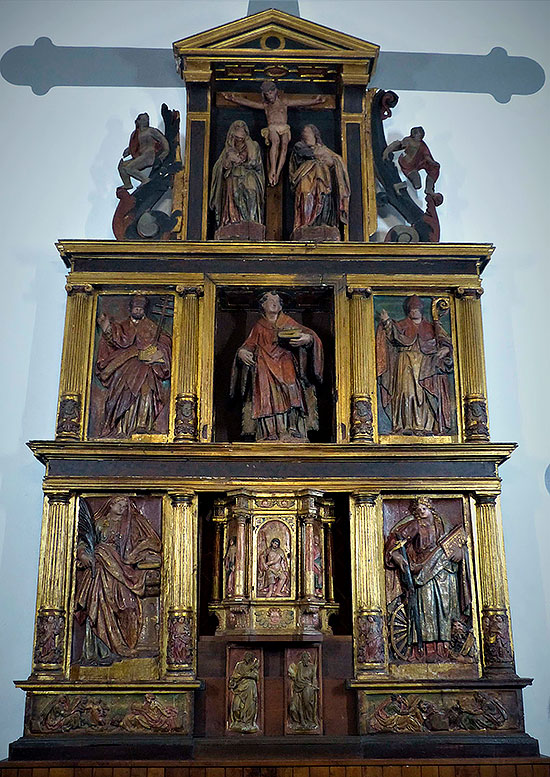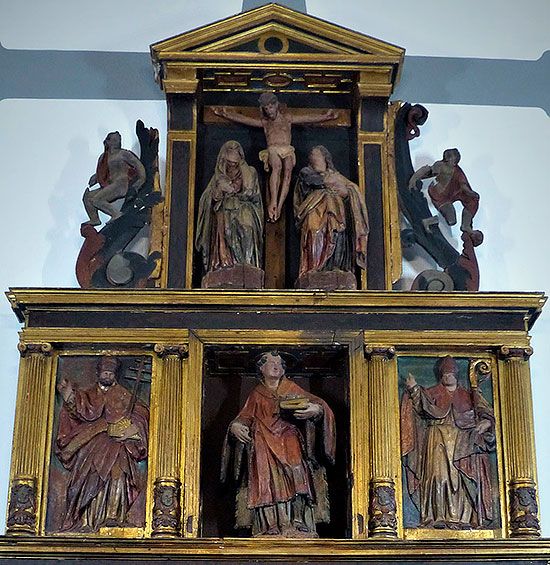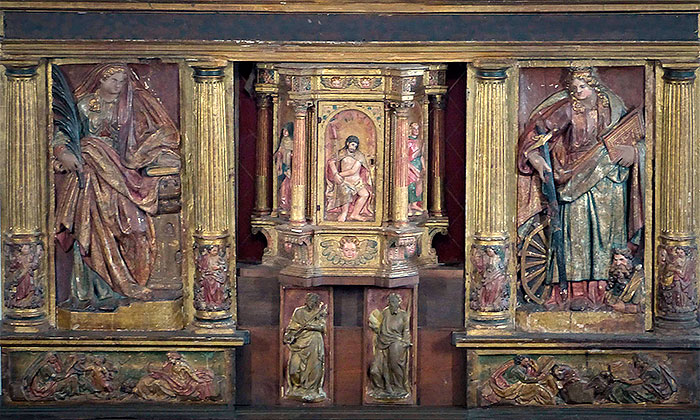The piece of the month of June 2023
THE SCULPTOR JUAN DE LANDA, AUTHOR OF THE ROMANIST ALTARPIECE
OF LATASA (1597-1599)
Pedro Luis Echeverría Goñi
University of the Basque Country
The main altarpiece of the parish of San Esteban de Latasa, in the valley of Imotz, is a late 16th century Romanesque work by Juan de Landa y Gulina, a sculptor from Villanueva de Araquil / Hiriberri. In the second half of the 16th century, one of the most important polychrome altarpiece workshops of the Navarrese Renaissance was located in this locality, in which the Marsal, Landa and Elordi family clans stood out, supplying a large regional market in the surrounding valleys, mainly in the northwestern valleys. Both the workshop and its members have not yet been studied as a whole.
The Landa dynasty began with the carver of Alavese origin Juan de Landa Chinchetru († 1564) and continued with his son Pedro de Landa Marsal († 1575), who qualified as a sculptor. His eldest son, Juan de Landa y Gulina I († 1611), will become a good Romanist sculptor, although the most qualified artist will be his brother, also called Juan de Landa († 1613), who will become king of arms and one of the best Mannerist painters of Navarre. The painter-decorators Felipe de Landa Moret († 1628) and Pedro de Landa Moret († 1645), sons of our sculptor, close this fertile clan.
The contract for the main altarpiece of Latasa was formalized on November 3, 1597 between its patrons, the abbot Pedro de Larumbe and Juan de Latasa, lieutenant of merino and secular primitiary, and the sculptor Juan de Landa. The deed was made according to the Synodal Constitutions of the bishopric of Pamplona, recently promulgated in 1591, following a mandate of visit due to the lack of an altarpiece in the church, and after obtaining the preceptive licence from the diocesan vicar of the bishop Antonio Zapata.
The deadline execution time was set at two years and, once completed, it was to be assembled in the main chapel of the church. The iconographic program, technique and location are precisely detailed, which would be respected in the final work, as we will see later. The first clause specifies that the images were to be carved in "til wood" or linden wood, compact, light-colored, easy to work with and resistant to xylophages. It was widely used in Navarre by Gallic carvers such as Pierres Picart and the members of his workshop. Along with reliefs and bulges, it includes the obligation to make "half columns of average carving". Among the witnesses is Juan de Echalecu, archivist, a resident of that locality, who surely intervened in the assembly of the altarpiece.
For the payments a first submission of 50 ducats is established, running the first 15 to position of Lope de Satrústegui, son-in-law of the palace of Latasa, who owed that amount to the church; the rest would be satisfied by the factory, giving him five ducats for Christmas Day, 25 for San Juan of June and as many, for Christmas of 1598. Finally, the patrons undertook to pay him from the fruits of their own and their successors until the amount of the appraisal of the altarpiece was fully satisfied. Faced with a series of repair works that were presented in the factory, the sculptor accepted a reduction of one ducat of the primary fruits. The polychrome complement "del natural" was done at position by Pedro de Landa, son of the author of the altarpiece, who gilded and stewed it with beautiful bouquets, only preserved in the vestments, work that was appraised in 1644 by León de Iribarren and Lucas de Pinedo in 3,263 reals.

Latasa. Parish of San Esteban. Main altarpiece
It is an altarpiece of reduced dimensions that, adapted to the chevet of the old proto-Gothic church, is diluted in the present straight presbytery of the 18th century, where it was moved. It responds to the subject of altarpiece facade, in which the horizontality predominates, with very molded cornices. It consists of bank, two bodies of three streets and attic between aletones. It is compartmentalized in rectangular boxes that hold the tabernacle and bundles in the central street and high reliefs on the bench and side streets, topping the set a triangular pediment. The boxes of the second body are smaller due to optical correction. The elements of articulation are half columns, in which the superposition of orders of agreement is observed with the tectonics: Tuscan in the first body, Ionic in the second and Mannerist hooked pilasters in the attic. The columns have fluted shafts and the lower third is carved.
Its sober ornamental repertoire, in keeping with post-Tridentine postulates, is limited to the angels and cherub heads with garlands on the thirds of the columns, the geometric chains of the intrados of the boxes and the fins of the attic, on which sit Romanesque "chicotes". These are significantly similar to those of a correiform cartouche that serves as a colophon to the aforementioned book of the Synodal Constitutions of the bishopric of Pamplona in 1591.

Second body and attic
It is an altarpiece of isolated or paired saints and without stories, following the model of other Romanists such as those of Añorbe or Imárcoain. It highlights specific devotions, as reminders of dogmas and examples to follow, as indicated in the Decree on the Images. It is presided over by Saint Stephen, who is the only round lump, flanked by the high reliefs of Saint Gregory the Great and Saint Augustine blessing, similar to those of the Eraso altarpiece, which emphasize the authority of the pope and the prelates. On both sides of the tabernacle are those of St. Barbara and St. Catherine, virgins and martyrs, occupying the attic the essential Calvary, as the culmination of the Redemption. The bench is occupied by the seated and paired evangelists, St. Matthew and St. Mark, and St. Luke and St. John, symbolic foundations as depositaries of the revealed truth.
We find here several prototypes of Michelangelesque mannerism only ten years after the death of Juan de Anchieta. Its monumentality is given by the anatomical exaltation, reinforced by heavy fabrics. The saints are classical matrons with Hellenic profile and the saints show stern expressions. Some poses studied are the contrapostos with feet on plinths, the declamatory attitudes or the energetic crossing of arms.

First body and tabernacle from Moriones
Of the original tabernacle, only the smeared reliefs of St. Peter and St. Paul, which occupied the lateral intercolumniations, have survived to the present day. Today we see them resting on the plinth of the current tabernacle which, coming from Moriones (Val de Aibar), was transferred here in 1975. Since it is a Romanesque reliquary, it fits perfectly in this altar. It has a trapezoidal plan and consists of a bench, Corinthian columns on double volute corbels and angel heads on the bench and frieze. In the doorway sample a high relief of the Ecce Homo, and in the side streets, the Virgin and St. John. In addition, as chance would have it, an altarpiece made by the sculptor Juan de Landa is joined here with this tabernacle, from the workshop of Sangüesa-Lumbier, which was polychromed by his younger brother of the same name, the king of arms Juan de Landa, and which was valued on March 6, 1606, at 120 ducats. The interior is painted with a bust of Christ in the background and colorful bouquets.
SOURCES AND BIBLIOGRAPHY
AGN. Prot. Not. Villanueva de Araquil. Martín de Ureta, 1596-1601, no. 33.
AD. Pamplona. Oteiza. C/1056, no. 21.
AGN. Prot. Not. Mendigorría. Juan Igal, 1607, nos. 14 and 15.
GARCÍA GAINZA, M.ª C. (dir.) and others, Catalog Monumental de Navarra, V** Merindad de Pamplona, Pamplona, Gobierno de Navarra, 1996, pp. 11-12.
